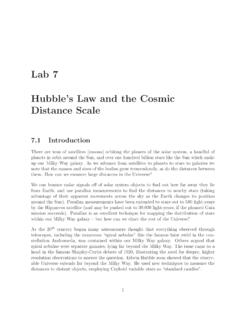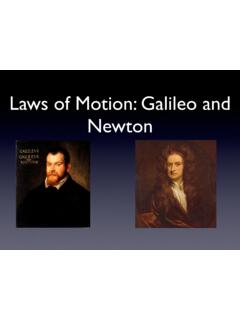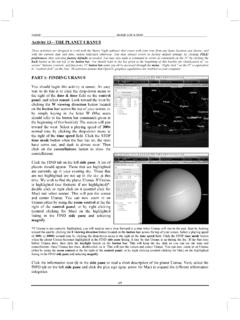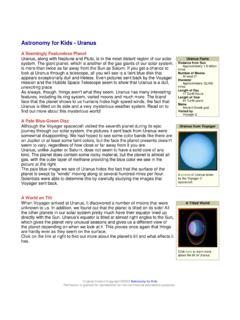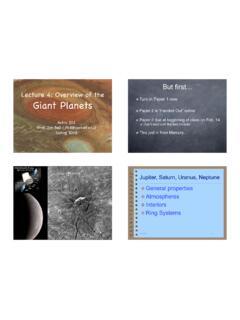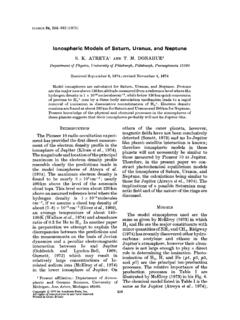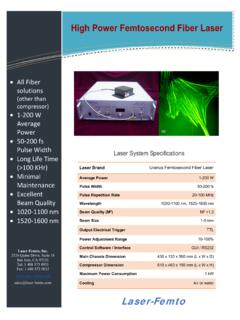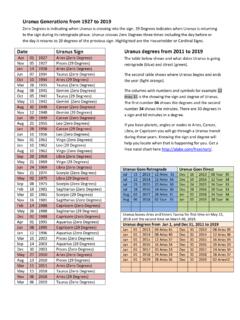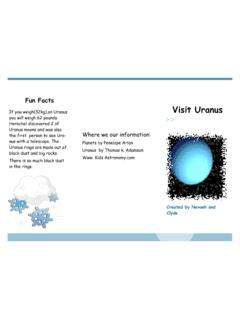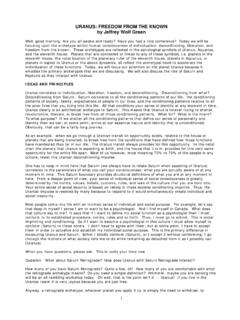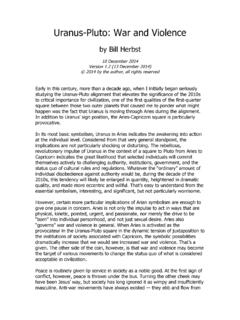Transcription of Uranus and Neptune - NMSU Astronomy
1 Jovian Planets II: Uranus and Neptune Jovian planets:Large, gaseous objects. They are composed mostly of hydrogen and helium. Each jovian planet has rings. There are many moons of all (AU)Radius(Earth radii)Mass(Earth Masses)Density(g/cm3) Uranus Uranus was discovered by William Hershel in 1781 Planet ProfileDiameter (km) ..51118 Mean density (g/cm^3) .. velocity (km/sec).. distance from Sun (AU) .. period (length of day in Earth hours).. period (length of year in Earth years)..84 Obliquity (tilt of axis in degrees) .. temperature (K) ..59 Atmospheric hydrogen, 15% helium, 2% methane (at depth) has a system of narrow, faint rings. Ring particles are dark, and could consist of rocky or carbonaceous greenish color of Uranus ' atmosphere is due to methane and high-altitude photochemical smog. Voyager 2 acquired this view of the seventh planet while departing the Uranian system in late January 1986.
2 This image looks at the planet approximately along its rotational of UranusThis image reveals many broad lanes of dust surrounding the 9 main rings of Uranus . It was taken by Voyager 2 looking back toward the sun through the ring system. The dust is especially bright in this view, for the same reason that we can see dust on a windshield better when we are driving toward the sun. The rings of Uranus are actually very dark. The short stubby streaks are stars slightly smeared during the long discovery of two "shepherd" satellites has advanced our understanding of the structure of the Uranian rings. The moons, designated 1986U7 (Cordelia) and 1986U8 (Ophelia), are seen here on either side of the bright epsilon ring and are believed to confine it by their gravitational effects. Inward from the epsilon ring are the delta, gamma, eta, beta and alpha rings. The 4, 5, and 6 rings are barely visible inward from there. The rings have been studied since their discovery in 1977. The epsilon ring appears surrounded by a dark band as a result of the image of UranusMiranda is the innermost of the large Uranian satellites.
3 Its surface is composed mostly of rolling cratered plains that probably date back to the early evolution of the solar system when impact rates were extremely high. Half of Miranda's surface is younger based on the fewer number of craters; it consists of complex sets of parallel and intersecting scarps and ridges. The bright V-shaped feature in the grooved area is Inverness Corona, and has been nicknamed the "Chevron". The huge, jagged canyon on the right limb is in the direction of Uranus -- A fracture or zone of fractures in a planet's crust, accompanied by displacement of the opposing -- A long, relatively depressed crustal unit or block that is bounded by faults along its sides; a -- A cliff or steep slope of some extent that may form a marked topographic small number of craters indicates that this extensive system of faults is younger than the surrounding heavily cratered terrain. Some of the dark material inside the Chevron may be igneous material ejected along the fault planes.
4 The lower image offers a perspective view of the same region shown in the top. It was generated from a computer model of the surface topography. The relief is exaggerated by about 50- fold; the view angle is about 15 degrees above the largest fault scarp is seen below and right of center; it shows grooves probably made by the fault blocks as they rubbed against each other (leaving what are known as slickensides). Movement of the down-dropped block is shown by the offset of the ridges. The fault may be 5 km (3 mi) high, or higher than the walls of the Grand Canyon on complex terrain of Ariel is captured in this view of its southern hemisphere. Most of the surface consists of intensely cratered terrain transected by fault scarps and graben. Some of the largest graben, which can be seen near the terminator (at right), are partly filled with younger deposits that are less heavily cratered. Bright spots near the limb and toward the left are chiefly the rims of craters. Most of the brightly rimmed craters are too small to be resolved here, although one crater about 30 km (20 mi) in diameter is easy to spot near the Neptune Discovered by german astronomer Galle in 1846 NeptunePlanet ProfileDiameter (km).
5 49528 Mean density (g/cm^3) .. velocity (km/sec).. distance from Sun (AU).. period (length of day in Earth hours).. period (length of year in Earth years).. (tilt of axis in degrees).. temperature (K)..48 Atmospheric hydrogen, 25% helium, 1% methane (at depth) are narrow, and contain concentrations of particles called ring three features visible here are among the most interesting on Neptune . At the top is the Great Dark Spot, accompanied by bright, white clouds that change rapidly with time. Below the dark spot is a bright feature that scientists nicknamed "Scooter." Below Scooter is the Small Dark Spot. All three features move eastward at different velocities, so it is rare that they can all be photographed linear clouds are stretched approximately along lines of constant latitude and the sun is toward the upper left. The sides of the clouds facing the sun are brighter than the surrounding cloud deck because they are more directly exposed to the sun.
6 Shadows are visible on the side opposite the rings around Neptune are so faint that when Voyager's cameras captured this image, the brightness of Neptune nearly made them impossible to detect. The black box in the center of the image is where Neptune was blocked out because no detail was visible given the long exposure time required to capture the almost invisible rings. The bright glow at the edges of the black box is some of the light reflected from Neptune . Two sharp rings are visible, Leverrier and Adams, and one faint ring, Galle, is barely visible inside an average radius of only 200 km (120 mi), this tiny half-illuminated satellite appears spectrally gray with an albedo of 6%. Hints of crater-like forms and groove-like lineations can be irregular shape of Proteus suggests that it has been cold and rigid throughout its history and subject to significant impact cratering. The satellite has an average radius of about 200 km (120 mi)The pink hue of Neptune 's largest moon, Triton, is thought to result from a slowly evaporating layer of nitrogen ice.
7 Triton is an oddity among moons in that its orbit is highly tilted to the plane of Neptune 's equator, and it is in a retrograde orbit. These facts have led scientists to believe that Triton formed independently of Neptune and was later captured by Neptune 's 's surface is covered with nitrogen and methane ice. Its surface temperature is a mere 38 degrees Celsius above absolute zero. Dark streaks across the south polar cap may be the result of recent geyser-like eruptions of gas, dust, and ice venting from beneath the cap into the satellite's near-vacuum atmosphere. The diameter of Triton is 2700 km (1674 mi).PlutoPlanet ProfileDiameter (km) ..2300 Mean density (g/cm^3) .. velocity (m/sec)..1100 Average distance from Sun (AU) .. period (length of day in Earth days).. period (length of year in Earth years).. temperature (K)..37 Atmospheric methane and nitrogen Surface methane iceBornFebruary 4, 1906 in a ranch near Streator, Illinois, DiedJanuary 17, 1997 (aged 90) Las Cruces, New Mexico, TombaughTombaugh was employed at the Lowell Observatory from 1929 to 1930 he discovered his discovery of Pluto, Tombaugh earned bachelor's and master's degrees in Astronomy from the University of Kansas in 1936 and 1938.
8 During World War II he taught naval personnel navigation at Northern Arizona University. He worked at the White Sands Missile Range in the early 1950s, and taught Astronomy at New Mexico State University from 1955 until his retirement in 1973.
